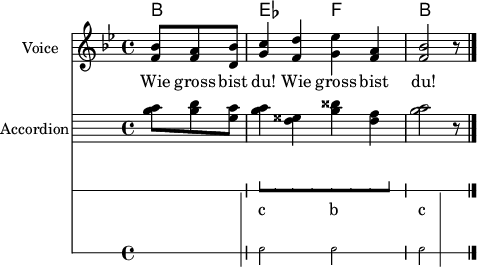⌂ Score for diatonic accordion
A template to write a score for a diatonic accordion.
- There is a horizontal staff indicating if the accordion must be pushed (thick line) or pulled (thin line).
- There is a small rhythmic staff with lyrics that describes the bass buttons to press. The bar lines are made from gridlines.
- The tabulator staff for diatonic accordions shows the geographic position of the buttons and not (as for every other instrument) the pitch of the notes; the keys on the melody side of the accordion are placed in three columns and about 12 rows.
In the tabulator staff notation the outermost column is described with notes between lines, the innermost column is described with notes between lines and a cross as accidental, and the middle column is described with notes on a line, whereby the row in the middle is represented on the middle line in the staff.
Some words to transpose piano notes to the diatonic accordion:
- Every diatonic accordion is built for some keys only (for example, for the keys of C major and F major), so it is important to transpose a piano melody to match one of these keys. Transpose the source code, not only the output because this code is required later on to translate it once more to the tabulator staff. This can be done with the command
displayLilyMusic.
- You have to alternate the push- and pull-direction of the accordion regularly. If the player has a too long part to pull the accordion gets broken. On the other hand, some harmonies are only available in one direction. Considering this, decide which parts of the melody are the push-parts and which the pull-parts.
- For each pull- or push-part translate the piano notes to the according tabulature representation.
